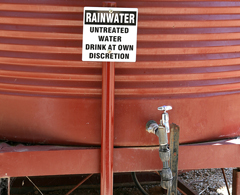
Drinking water from rain tanks, bores and even dams is great when you know the water is safe. However, sometimes prolonged dry periods, contamination from dust, livestock, birds, algae and even insect plagues can affect the quality of your drinking water.
Parasites can be ingested from drinking rainwater, particularly after periods of heavy rain or when the tank water is low. Dirt from the roof, including animal faeces and germs, carried in the wind can blow onto the roof and flow into the tank. This can lead to diseases, such as Blastocystis. Seepage from septic tanks, intensive farming operations or pesticide drift can also contaminate your drinking water supply. More recently climate variability has increased the number of algal blooms which can also be toxic.
If you suspect water may be contaminated, boil or filter your drinking water. You may need to consider treating it with a disinfectant – for more information on how you can treat water at your home visit the “Guide to Drinking Water Treatment Technologies for Household Use”.
Drinking untreated water such as creek water, bore water or sometimes even rainwater can lead to illnesses including gastroenteritis. Natural water sources should be used with caution and water treatment methods can be used to ensure your water is safe to drink.
Remember, think before you drink and treat the water if you are unsure. It is a good idea to take a bottle of clean drinking water with you if you are out on the farm.
Find out more about this topic on Better Health Channel
Fast facts:
- Tanks, creeks, bore water and dams can be infected with waterborne diseases, especially after storms or floods.
- Contaminated water can cause sicknesses such as gastroenteritis and diarrhoea.
- The best way to kill waterborne bacteria is to boil the water before drinking. Filtration works very effectively too.
References used for this topic page
More information:
Department of Health
Your Private Drinking Water Supply
Centers for Disease Control (US)
Global Water, Sanitation, and Hygiene (WASH)
Centres for Disease Control (US)
A Guide to Drinking Water Treatment Technologies for Household Use
Department of Water, Government of Western Australia
Safe use of bore water in rural areas
Environmental Protection Agency (US)
Private Drinking Water Wells
Centers for Disease Control and Prevention
Making water safe
Research & reviews:
Centers for Disease Control (US)
Surveillance for waterborne disease and outbreaks associated with drinking water and water not intended for drinking – United States, 2005-2006
|
|